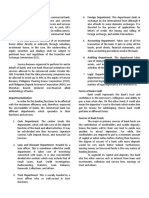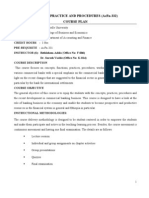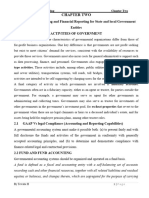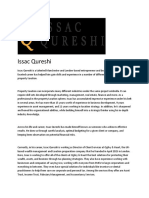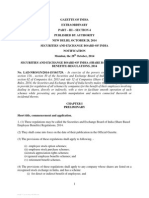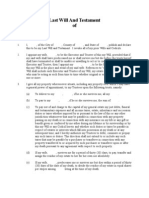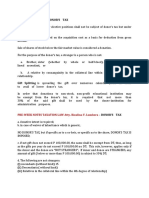Government Accounting (AFA-II) : Governmental Entities: Introduction and General Fund Accounting
Government Accounting (AFA-II) : Governmental Entities: Introduction and General Fund Accounting
Uploaded by
Md. Rejaul Ahsan Chowdhury100%(1)100% found this document useful (1 vote)
50 views8 pagesThis document discusses governmental accounting principles and practices. It explains that governmental entities have different objectives than commercial entities, focusing on fulfilling societal needs rather than profit. Governmental accounting uses funds to separately track financial resources and their uses. The general fund accounts for basic governmental services, while other funds are used for specific purposes like capital projects or debt service. When recording budgets, estimated revenues and appropriated expenditures are recorded as anticipatory accounts, with the difference posted to the budgetary fund balance.
Original Description:
Original Title
Governmental Entities
Copyright
© © All Rights Reserved
Available Formats
DOC, PDF, TXT or read online from Scribd
Share this document
Did you find this document useful?
Is this content inappropriate?
Report this DocumentThis document discusses governmental accounting principles and practices. It explains that governmental entities have different objectives than commercial entities, focusing on fulfilling societal needs rather than profit. Governmental accounting uses funds to separately track financial resources and their uses. The general fund accounts for basic governmental services, while other funds are used for specific purposes like capital projects or debt service. When recording budgets, estimated revenues and appropriated expenditures are recorded as anticipatory accounts, with the difference posted to the budgetary fund balance.
Copyright:
© All Rights Reserved
Available Formats
Download as DOC, PDF, TXT or read online from Scribd
Download as doc, pdf, or txt
100%(1)100% found this document useful (1 vote)
50 views8 pagesGovernment Accounting (AFA-II) : Governmental Entities: Introduction and General Fund Accounting
Government Accounting (AFA-II) : Governmental Entities: Introduction and General Fund Accounting
Uploaded by
Md. Rejaul Ahsan ChowdhuryThis document discusses governmental accounting principles and practices. It explains that governmental entities have different objectives than commercial entities, focusing on fulfilling societal needs rather than profit. Governmental accounting uses funds to separately track financial resources and their uses. The general fund accounts for basic governmental services, while other funds are used for specific purposes like capital projects or debt service. When recording budgets, estimated revenues and appropriated expenditures are recorded as anticipatory accounts, with the difference posted to the budgetary fund balance.
Copyright:
© All Rights Reserved
Available Formats
Download as DOC, PDF, TXT or read online from Scribd
Download as doc, pdf, or txt
You are on page 1of 8
Government Accounting (AFA-II)
Governmental Entities: Introduction and General Fund Accounting
• Governmental entities have operating objectives different from those of commercial
entities; therefore, governmental accounting is different from accounting for commercial
enterprises
• Nature of governmental entities:
a. Collect resources and make expenditures to fulfil societal needs
b. Absence of profit motive except for some activities
c. Have legal authorization for their existence, conduct revenue-raising through the
power of taxation, and have mandated expenditures they must make to provide
their services
d. Control mechanism - Use of comprehensive budgetary accounting
e. Accountability for the flow of financial resources is a chief objective
f. Typically are required to establish separate funds to carry out various missions;
each fund is an independent accounting and fiscal entity
g. Many fund entities do not record fixed assets or long-term debt in their funds
h. An important objective of governmental financial reporting is accountability
Elements of a statement of financial condition:
1. Assets are resources with present service capacity that the entity presently controls
2. Liabilities are present obligations to sacrifice resources that the entity has little or no
discretion to avoid
3. A deferred outflow of resources is a consumption of net assets that is applicable to a
future reporting period
4. A deferred inflow of resources is an acquisition of net assets that is applicable to a
future reporting period
5. Net position is the residual of all other elements presented in a statement of financial
condition
Elements of the resource flows statements:
1. An outflow of resources is a consumption of net assets that is applicable to the
current reporting period
2. An inflow of resources is an acquisition of net assets that is applicable to the
current reporting period
Expendability of resources versus capital maintenance objectives:
Commercial Enterprises Government Entities
Changes in current financial
resources available to provide
services to the public in
Measurement focus The flow of all economic resources accordance with the budget
Method of Accounting Accrual method Modified accrual method
Contains both current and
noncurrent assets and liabilities, and
the change in retained earnings Reports only current assets,
reflects the company’s ability to current liabilities, and a fund
Balance sheet maintain its capital investment balance
• Types of funds
– Governmental Funds:
• Used to provide basic governmental services to the public
• Each entity creates only one general fund, but it may create more
than one of each of the other types of funds
– Proprietary Funds
• The objective is to recover the unit’s costs through user charges
– Fiduciary Funds
Governmental Fund Types
General fund Accounts for all financial resources except for those
accounted for in another fund. Includes transactions for
general governmental services provided by the executive,
legislative, and judicial operations of the governmental
entity.
Special revenue fund Accounts for the proceeds of specific revenue sources
that are restricted for specified purposes.
Capital projects fund Accounts for financial resources for the acquisition or
construction of major capital facilities that benefit many
citizens, such as parks and municipal buildings.
Debt service fund
Accounts for the accumulation of resources for, and the
payment of, general long-term debt principal and interest.
Permanent fund Accounts for resources that are restricted such that only
earnings, but not principal, may be used in support of
governmental programs that benefit the government or its
citizenry.
Proprietary Fund Types
Enterprise fund Accounts for operations of governmental units that
charge for services provided to the general public.
Internal service fund Accounts for the financing of goods or services provided
by one department or agency to other departments or
agencies of the governmental unit. Services are offered
only to governmental agencies.
Fiduciary Fund Types and Similar Component Units
Pension (and other Accounts for resources required to be held in trust for the
employee benefit) trust members and beneficiaries of pension plans, other post-
fund employment benefit plans, or other EBPs.
Investment trust fund Accounts for the external portion of investment pools
reported by the sponsoring government.
Private-purpose trust Accounts for all other trust arrangements under which the
fund fund’s resources are to be used to benefit specific
individuals, private organizations, or other governments.
Agency fund Accounts for assets held by a governmental unit in an
agency capacity for employees or for other governmental
units.
Basis of accounting—governmental funds
– Revenue is recorded in the accounting period in which it is both measurable and available to
finance expenditures made during the current fiscal period
– Expenditures are recognized in the period in which the liabilities are both measurable and
incurred and are payable out of current financial resources
Recognition of revenue: How revenues are recognized depends on the category:
• Derived tax revenues, resulting from assessments on exchange transactions
– The asset is recognized when the underlying transaction occurs or resources are
received, whichever comes first
– Revenue recognition depends on the accounting basis used to measure the
transaction
• Imposed nonexchange revenues, resulting from assessments on nongovernmental entities,
including individuals
– The asset is recognized when the government has an enforceable legal claim to
the resources or the resources are received, whichever comes first
– Revenue recognition is made in the period when use of the resources for current
expenditures is first permitted or required, or at the time the asset is recorded if no
time restriction on the fund’s use of the resources exists
Imposed nonexchange revenues, resulting from assessments on nongovernmental entities,
including individuals
– The asset is recognized when the government has an enforceable legal claim to
the resources or the resources are received, whichever comes first
– Revenue recognition is made in the period when use of the resources for current
expenditures is first permitted or required, or at the time the asset is recorded if no
time restriction on the fund’s use of the resources exists
• Recognition of revenue:
– Government-mandated nonexchange transactions, resulting from one
governmental unit’s provision of resources to a governmental unit at another level
and the requirement that the recipient use the resources for a specific purpose
– Voluntary nonexchange transactions, resulting from legislative or contractual
agreements, other than exchanges
• Budgets
– Used in governmental accounting to assist in management control and to provide
the legal authority to levy taxes, collect revenue, and make expenditures in
accordance with the budget
– Types of budgets:
• Operating budgets
• Capital budgets
Recording the Operating Budget
Assume that at January 1, 20X1, the first day of the new fiscal period, the city council of Barb
City approves the operating budget for the general fund, providing for $900,000 in revenue and
$850,000 in expenditures. Approval of the budget provides the legal authority to levy the local
property taxes and to appropriate resources for the expenditures. The entry made in the general
fund’s accounting records on this date is as follows:
– The ESTIMATED REVENUES CONTROL account is an anticipatory asset
– The APPROPRIATIONS CONTROL account is an anticipatory liability
– The excess of estimated revenues over anticipated expenditures is the budget surplus and
is recorded to BUDGETARY FUND BALANCE—UNRESERVED
– Some approved budgets have budget deficits in which expected expenditures exceed
anticipated revenue
– These budgets are recorded with a debit to BUDGETARY FUND BALANCE—
UNRESERVED
The Expenditure Process
– Step 1. Appropriation
• The budget provides the appropriating authority to make future
expenditures
– Step 2. Encumbrance
• An encumbrance is a reservation of part of the budgetary appropriation
and is recognized at the time an order is placed for goods or services
– Step 3. Expenditure
• An expenditure and a corresponding liability are recorded when the
governmental entity receives the goods or services ordered in step 2
– Step 4. Disbursement
• A disbursement is the payment of cash for expenditures
Classification of expenditure transactions and accounts
– Expenditures should be classified by fund, character, function (or program),
organizational unit, activity, and principal classes of objects
Outstanding encumbrances at the end of the fiscal period:
– May be allowed to lapse
– May be carried over as nonlapsing spending authority
Expenditures for inventory
– Determining the method to account for the expenditure of inventories:
• Purchase method: Recognizes the entire expenditure for inventory in the
period the supplies are acquired
• Consumption method: Recognizes expenditures for only the amount of
inventory used in the period
– The specific method to follow depends on the governing unit’s policy and how
inventory expenditures are included in the budget
– Immaterial inventories need not be shown on the balance sheet
– If the inventory is material, it is presented as an asset on the balance sheet
• An amount equal to the inventory also should be shown as a reservation of
the fund balance, indicating that that amount is no longer expendable
Interfund Activities
Overview of Accounting and Financial Reporting for the General Fund
You might also like
- A Guide To Zimbabwe Taxation NyatangaDocument303 pagesA Guide To Zimbabwe Taxation NyatangaAlbert Murutayi100% (1)
- FM CH 1natureoffinancialmanagement 120704104928 Phpapp01 PDFDocument28 pagesFM CH 1natureoffinancialmanagement 120704104928 Phpapp01 PDFvasantharao100% (1)
- 2019 10 01 - Deed of Appointment of Trustee (Revised DRAFT)Document3 pages2019 10 01 - Deed of Appointment of Trustee (Revised DRAFT)MANUELITONoch keine Bewertungen
- Assignment - LLC Membership Interests in - (1 Person)Document2 pagesAssignment - LLC Membership Interests in - (1 Person)crystalNoch keine Bewertungen
- Former President Trump's Attorney's Letter To Town of Palm BeachDocument3 pagesFormer President Trump's Attorney's Letter To Town of Palm BeachWTSP 10Noch keine Bewertungen
- Chapter Two Principles & Basis of Accounting For Government & NFP EntitiesDocument10 pagesChapter Two Principles & Basis of Accounting For Government & NFP Entitiesmeron fitsum100% (1)
- Government and Non Profit AccountingDocument9 pagesGovernment and Non Profit AccountingMesay Adane100% (1)
- UNIT 2 NEW GoverntDocument14 pagesUNIT 2 NEW GoverntYosef Mitiku100% (1)
- Chapter-Six Accounting For General, Special Revenue and Capital Project FundsDocument31 pagesChapter-Six Accounting For General, Special Revenue and Capital Project FundsMany Girma100% (2)
- Chp-4 Capital Project FundDocument8 pagesChp-4 Capital Project FundkasimNoch keine Bewertungen
- GNFP CH 3Document41 pagesGNFP CH 3Bilisummaa GeetahuunNoch keine Bewertungen
- Accrual Accounting ProcessDocument52 pagesAccrual Accounting Processaamritaa100% (1)
- Ch.2 PGDocument12 pagesCh.2 PGkasimNoch keine Bewertungen
- Mergers and Acquisitions Notes at Mba Bec Doms of FinanceDocument15 pagesMergers and Acquisitions Notes at Mba Bec Doms of FinanceBabasab Patil (Karrisatte)100% (1)
- Financial Institutions in The Financial SystemDocument15 pagesFinancial Institutions in The Financial SystemNigussie Berhanu100% (1)
- Chapter 3 3-1. The Solution To ThisDocument13 pagesChapter 3 3-1. The Solution To Thisericle8750% (2)
- HTTPS:/WWW Fiscal Treasury Gov/files/ussgl/fsreports/tfintro PDFDocument4 pagesHTTPS:/WWW Fiscal Treasury Gov/files/ussgl/fsreports/tfintro PDFNelson HarrisNoch keine Bewertungen
- Fabozzi Bmas8 PPT Ch01Document22 pagesFabozzi Bmas8 PPT Ch01Leslie RomeroNoch keine Bewertungen
- Principles of Security AnalysisDocument6 pagesPrinciples of Security AnalysisSheila Mae MalesidoNoch keine Bewertungen
- History of Auditing in Ethiopia ppt-1Document35 pagesHistory of Auditing in Ethiopia ppt-1bqandaloNoch keine Bewertungen
- SEBI Role and FunctionsDocument28 pagesSEBI Role and FunctionsAnurag Singh100% (4)
- Compiled by Birhanu M (MBA-Finance) Page 1Document9 pagesCompiled by Birhanu M (MBA-Finance) Page 1Nigussie BerhanuNoch keine Bewertungen
- Week 3 Answers To Questions Final DFTDocument10 pagesWeek 3 Answers To Questions Final DFTGabriel Aaron Dionne0% (1)
- Universal BankDocument1 pageUniversal Bankhailene lorenaNoch keine Bewertungen
- FinanzverwaltungDocument51 pagesFinanzverwaltungarjunmba119624100% (1)
- Portfoliopractice IFRS Accounting of Pension ObligationsDocument24 pagesPortfoliopractice IFRS Accounting of Pension ObligationsvalentbrNoch keine Bewertungen
- CH 01 - Inter Corporate Acquisitions and Investments in Other EntitiesDocument37 pagesCH 01 - Inter Corporate Acquisitions and Investments in Other EntitiesMerriam Leirose Daganta Cabidog100% (3)
- Financial Reporting and Changing PricesDocument6 pagesFinancial Reporting and Changing PricesFia RahmaNoch keine Bewertungen
- Dimensions of Cash Flow Management: Prof. N. C. KarDocument74 pagesDimensions of Cash Flow Management: Prof. N. C. KarAshok100% (1)
- Banking Practice & Proc. Course OutlineDocument5 pagesBanking Practice & Proc. Course OutlineSuresh Vadde50% (2)
- AUDITING of Banks FinalDocument50 pagesAUDITING of Banks Finaljeards24100% (2)
- Governmental Entities: Proprietary Funds, Fiduciary Funds,& Comprehensive Annual Financial ReportDocument27 pagesGovernmental Entities: Proprietary Funds, Fiduciary Funds,& Comprehensive Annual Financial ReportabmyonisNoch keine Bewertungen
- Financial Mangement Slides Lecture 1Document56 pagesFinancial Mangement Slides Lecture 1Aqash AliNoch keine Bewertungen
- Capital Project Fund IllustrationDocument2 pagesCapital Project Fund IllustrationMike Dolla SignNoch keine Bewertungen
- MGT 521 SyllabusDocument10 pagesMGT 521 SyllabusjohndoeuopNoch keine Bewertungen
- Definition Off Balance SheetDocument7 pagesDefinition Off Balance SheetdomomwambiNoch keine Bewertungen
- The Principle of Limited LiabilityDocument24 pagesThe Principle of Limited LiabilityMuhammad NumanNoch keine Bewertungen
- SPV1Document37 pagesSPV1ritu_gnimsNoch keine Bewertungen
- Illustration On Special Revenue FundDocument2 pagesIllustration On Special Revenue FundJichang Hik0% (1)
- Chapter 1 - New Government Accounting System (Ngas)Document28 pagesChapter 1 - New Government Accounting System (Ngas)MA ValdezNoch keine Bewertungen
- Chap 006Document51 pagesChap 006kel458100% (1)
- FINS5513 Security Valuation and Portfolio Selection Sample ExamDocument8 pagesFINS5513 Security Valuation and Portfolio Selection Sample Examoniiizuka100% (1)
- Analyzing Investing Activities: Intercorporate InvestmentsDocument34 pagesAnalyzing Investing Activities: Intercorporate InvestmentsVeenesha MuralidharanNoch keine Bewertungen
- Audit II 7new - 3Document15 pagesAudit II 7new - 3Muktar Xahaa100% (1)
- Banking Institutions History Classifications and FunctionsDocument13 pagesBanking Institutions History Classifications and FunctionsJessielyn GialogoNoch keine Bewertungen
- Introduction To Law On CooperativesDocument4 pagesIntroduction To Law On CooperativesSembrana CampuedNoch keine Bewertungen
- What Should Be The Fate of The Current Provisions Governing Joint Venture in The Forthcoming Revised Commercial Code of Ethiopia? Retention or Exclusion?Document18 pagesWhat Should Be The Fate of The Current Provisions Governing Joint Venture in The Forthcoming Revised Commercial Code of Ethiopia? Retention or Exclusion?melewon2Noch keine Bewertungen
- Public Sector AccountingDocument9 pagesPublic Sector AccountingBekanaNoch keine Bewertungen
- Sample Audit ReportsDocument44 pagesSample Audit Reportsyeosuf100% (1)
- Public Finance & Taxations CH 1-4Document177 pagesPublic Finance & Taxations CH 1-4fentawmelaku1993100% (1)
- Public Finance and TaxationDocument134 pagesPublic Finance and TaxationyebegashetNoch keine Bewertungen
- T10 Government AccountingDocument10 pagesT10 Government AccountingAiya LumbanNoch keine Bewertungen
- Capital expenditure Complete Self-Assessment GuideFrom EverandCapital expenditure Complete Self-Assessment GuideNoch keine Bewertungen
- Treasury Operations In Turkey and Contemporary Sovereign Treasury ManagementFrom EverandTreasury Operations In Turkey and Contemporary Sovereign Treasury ManagementNoch keine Bewertungen
- Dwnload Full Introduction To Governmental and Not For Profit Accounting 7th Edition Ives Solutions Manual PDFDocument36 pagesDwnload Full Introduction To Governmental and Not For Profit Accounting 7th Edition Ives Solutions Manual PDFmisdateholinessaubzt6100% (16)
- Chapter Two FundDocument7 pagesChapter Two FundTesfaye KebebawNoch keine Bewertungen
- GovaccDocument8 pagesGovaccJullienggcute LimbohopNoch keine Bewertungen
- Public Sector Handout 222Document29 pagesPublic Sector Handout 222HarusiNoch keine Bewertungen
- Chapter Two: Principles of Accounting and Financial Reporting For State and Local Governments (SLGS)Document55 pagesChapter Two: Principles of Accounting and Financial Reporting For State and Local Governments (SLGS)Bilisummaa GeetahuunNoch keine Bewertungen
- Government AccountingDocument93 pagesGovernment Accountingpilonia.donitarosebsa1993Noch keine Bewertungen
- Basic AccountingDocument14 pagesBasic AccountingRufina B VerdeNoch keine Bewertungen
- The Use of Funds in Governmental Accounting QuestionsDocument13 pagesThe Use of Funds in Governmental Accounting QuestionsBayzid BistamiNoch keine Bewertungen
- Chapter Two & Three: Priciples & Basis of Accounting For NFP Entities and Accounting & Budgeting ProcessDocument51 pagesChapter Two & Three: Priciples & Basis of Accounting For NFP Entities and Accounting & Budgeting ProcessabateNoch keine Bewertungen
- Chapter Five Accounting Cycle For Expendable (General and Special Revenue) FundsDocument22 pagesChapter Five Accounting Cycle For Expendable (General and Special Revenue) FundsHenok FikaduNoch keine Bewertungen
- Glorilyn M. Montejo 8-14 Cases On Double or Tax Exemption CIR vs. CA G.R. No. 95022 207 March 23, 1992 SCRA 487 Tax Exemption FactsDocument10 pagesGlorilyn M. Montejo 8-14 Cases On Double or Tax Exemption CIR vs. CA G.R. No. 95022 207 March 23, 1992 SCRA 487 Tax Exemption FactsAna leah Orbeta-mamburamNoch keine Bewertungen
- Supreme Court Reports Annotated 822Document11 pagesSupreme Court Reports Annotated 822ic corNoch keine Bewertungen
- Form 301-General Information (Application For Registration of A Foreign For-Profit Corporation)Document7 pagesForm 301-General Information (Application For Registration of A Foreign For-Profit Corporation)wavy2gravyNoch keine Bewertungen
- Bam 241: Business Laws and Regulations Second Periodical ExaminationDocument19 pagesBam 241: Business Laws and Regulations Second Periodical ExaminationGiner Mabale StevenNoch keine Bewertungen
- Issac QureshiDocument2 pagesIssac QureshiIssac QureshiNoch keine Bewertungen
- GCG MC No. 2012-02 - ReIssued - Revised Interim Rules On Directors Per Diem and Other Compensation EntitlementsDocument16 pagesGCG MC No. 2012-02 - ReIssued - Revised Interim Rules On Directors Per Diem and Other Compensation Entitlementscarlos borja jrNoch keine Bewertungen
- Securities and Exchange Board of India (Share Based Employee Benefits) Regulations, 2014Document19 pagesSecurities and Exchange Board of India (Share Based Employee Benefits) Regulations, 2014Shyam SunderNoch keine Bewertungen
- Documentary Stamp Tax - Bureau of Internal RevenueDocument12 pagesDocumentary Stamp Tax - Bureau of Internal RevenueKristarah HernandezNoch keine Bewertungen
- Deed OF Settlement OF Trust Between Settlor: "TrusteesDocument11 pagesDeed OF Settlement OF Trust Between Settlor: "TrusteesSRINIVASA MUGERAYANoch keine Bewertungen
- Ejercito v. Sandiganbayan (Bank Secrecy Law)Document2 pagesEjercito v. Sandiganbayan (Bank Secrecy Law)Patrick D GuetaNoch keine Bewertungen
- OCAMPO Vs OCAMPODocument9 pagesOCAMPO Vs OCAMPONullus cumunisNoch keine Bewertungen
- Aekpy3088c 2019Document4 pagesAekpy3088c 2019Ajay YadavNoch keine Bewertungen
- Glorilyn M. Montejo Alejandro Ty vs. Sylvia TyDocument1 pageGlorilyn M. Montejo Alejandro Ty vs. Sylvia TyGLORILYN MONTEJONoch keine Bewertungen
- Mccarron ComplaintDocument154 pagesMccarron ComplaintLatisha WalkerNoch keine Bewertungen
- Important Case Law Under Customs - CA Final Nov 20Document20 pagesImportant Case Law Under Customs - CA Final Nov 20Deepsikha maitiNoch keine Bewertungen
- Will - Married Man Without ChildrenDocument4 pagesWill - Married Man Without ChildrenLegal FormsNoch keine Bewertungen
- Jarantilla Jr. Vs Jarantilla (G.R. No. 154486)Document15 pagesJarantilla Jr. Vs Jarantilla (G.R. No. 154486)MarizPatanaoNoch keine Bewertungen
- PowerpointDocument15 pagesPowerpointJames PandianNoch keine Bewertungen
- O'Laco v. Co Cho ChitDocument2 pagesO'Laco v. Co Cho ChitRenzoSantosNoch keine Bewertungen
- Benami Property TransactionDocument27 pagesBenami Property TransactionBalaji KondaNoch keine Bewertungen
- 2016 Golden Beacon: - Donor'S TaxDocument10 pages2016 Golden Beacon: - Donor'S TaxBechay PallasigueNoch keine Bewertungen
- Trust Session 2 HeheDocument17 pagesTrust Session 2 HeheJerome MoradaNoch keine Bewertungen
- Hca001163 2013Document34 pagesHca001163 2013pschilNoch keine Bewertungen
- Case 2Document10 pagesCase 2ela kikayNoch keine Bewertungen
- Self CertificationDocument6 pagesSelf CertificationGuocheng MaNoch keine Bewertungen
- Republic of The PhilippinesDocument49 pagesRepublic of The PhilippinesChe PuebloNoch keine Bewertungen























